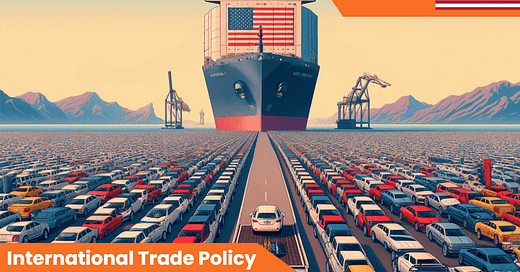Want to Understand How Trump's Tariffs Will Hurt the US Economy?
Then, you must understand how Ronald Reagan's voluntary export restraint failed.
The reality of Trump’s tariffs is sinking in, and some formerly clueless Trump supporters are learning how the tariffs will work against their economic interests. History is chock full of examples of how bad tariffs can be. A not-so-recent example we can learn from is how a threatened tariff in 1981 by newly elected Ronald Reagan cost American consumers billions and significantly skewed the growth of the American automobile industry.
After being elected, Reagan vowed to help the struggling U.S. auto industry fight off the rising competition, most significantly from Japan, Germany, and other rising economies. Japan had started flooding the U.S. market with low-priced, high-quality cars that appealed to struggling Americans. I recall my mother buying a Honda Civic in 1979, her first car since my parents divorced, and a sign of her rising independence. It was small, inexpensive, well-built, had a great radio, and needed almost no servicing, unlike the U.S.-made gas-guzzling behemoths. While older Americans disliked the “cars that help the enemy,” as my World War II veteran uncle called them, struggling young families found that purchasing such reliable, compact cars was a coup for balancing budgets.
However, Detroit hated the cars because they couldn’t build anything as reliable or cheaply. In comparison, many U.S. cars were simply too bulky, unattractive, broke down often, inhaled gas, and were just clunkers. Not wanting to stain the image of Republicans being pro-free trade, the Reagan administration asked the Japanese auto manufacturers to limit the number of cars they sold to the United States. The number was capped at 1.68 million cars. Called a “voluntary export restraint (VER),” the Japanese did not want to lose the American Klondike, so they accepted it.
Recent research (Berry, Levinsohn, and Pakes 1999) now gives us a clear picture of the all-too-predictable effects of this restriction on free trade: By limiting the supply of cars from Japan, the export restraints raised the prices of Japanese cars. This increased car sales by U.S. firms, thereby hiking their profits. All of this came chiefly at the expense of American auto consumers, particularly those who bought Japanese cars during this period. Overall, Americans as a whole were made worse off due to the introduction of the export restraints.
The key impacts were felt during 1986–1990. Over this period, the restraints (in essence, quotas) caused the prices of Japanese cars sold in the United States to average about $1,200 higher (in 1983 dollars), some 14 percent above what they would have been without the restraints (Voluntary Export Restraints).
As the world braces for Trump’s ridiculous tariffs and his base rejoices that jobs will return, prices will drop, and America will be made great again, the real inflationary effects will begin even before the tariffs are introduced. Companies, as well as individuals, will race to purchase inputs and goods, fearing the price increases. Slowly, Trump’s base is learning what happens when tariffs are put in place, so rather than wait, they will buy things today at the pre-tariff price.
In an economy as large as the U.S. and one so reliant on the just-in-time concept of warehousing and logistics, a sudden surge in consumer spending will reverse gains made by the Biden administration to fight inflation. After the tariffs are introduced, prices will increase even more, and the American consumers — families — will suffer the most, not the foreign manufacturers. Undoubtedly, the right-wing media and Trump will blame Biden and Democrats for the new inflation, and sadly, most dopey Trumpists will accept these lies as truth.
No good will come out of Trump’s hair-brained plan to punish foreign companies because the global economy is too intertwined. When the world punished Russia after its unprovoked invasion of Ukraine, few could have foreseen how the sanctions would hurt the Western economies. The increase in inflation was caused by both the struggles of the post-COVID supply chains and the rising energy costs and broken trade with Russia.
It is estimated that between 1981 and 1988, the U.S. consumer was penalized $8 billion because of the VER ($24 billion today). That cost was because of a voluntary restraint. Can you imagine what will happen when Trump puts tariffs on everything between 10 and 25 percent?
Ladies and gentlemen, we are collectively f*****!



